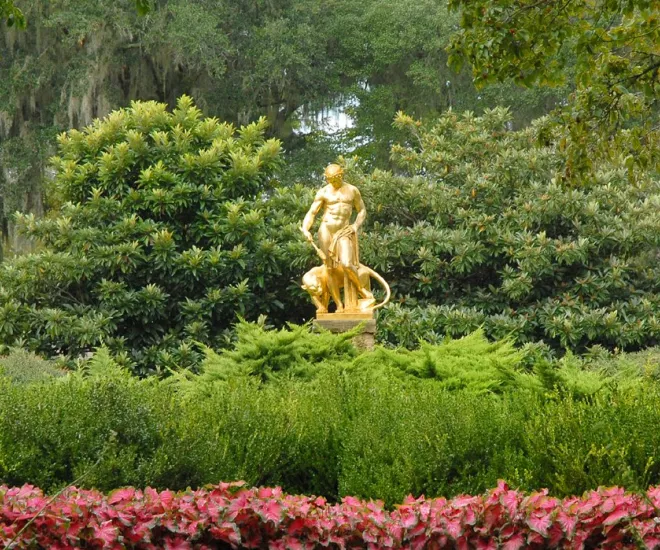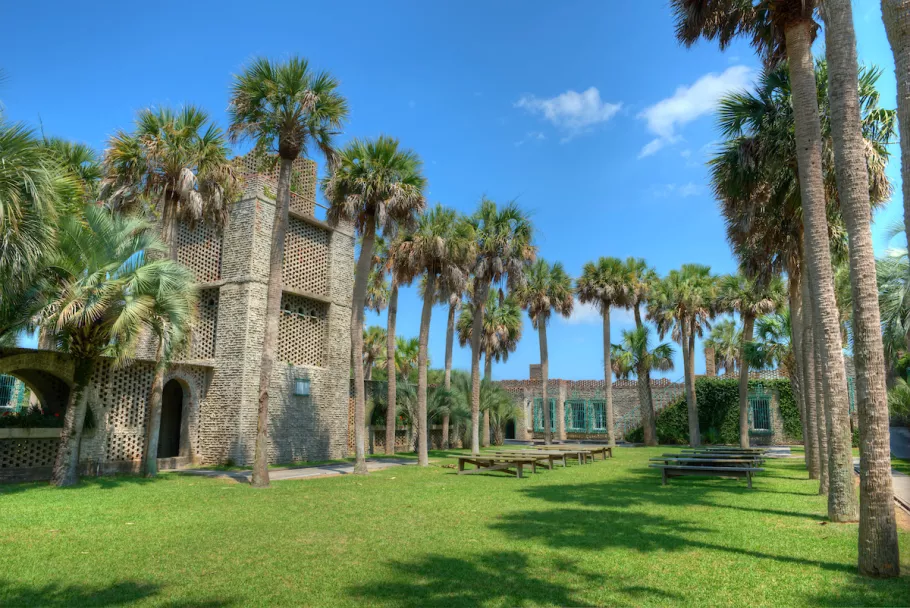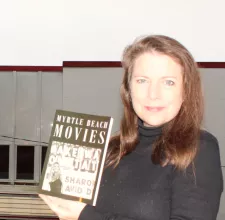Anna of Atalaya & Brookgreen Gardens

A world-renowned artist made the Grand Strand home
Two of the most wonderful places to visit just south of Myrtle Beach are Atalaya at Huntington Beach State Park and Brookgreen Gardens. They were created by philanthropist Archer Milton Huntington and his wife, world-renowned artist Anna Hyatt Huntington, in the 1930s.
What is now a premiere outdoor sculpture garden was made up of four former plantations: Laurel Hill, Springfield, Brookgreen and The Oaks. The best-known piece of sculpture at Brookgreen Gardens is at the entrance, Anna Hyatt Huntington’s own Fighting Stallions, which is indicative of her body of work.

She could sculpt anything, but thought animals were far more interesting than humans. However, there is a strong theme throughout her career of humans interacting with horses as seen in this particular piece. Her medium is aluminum which she embraced later in life as it didn’t weigh as much as bronze thereby making pieces more convenient to move to exhibitions. She felt that it always showed well no matter what the lighting.
Fighting Stallions was placed at the entrance in 1950 to draw attention to the gardens and attract visitors. She was 74 when she did it. She completed her last piece that was almost as large as that one when she was 91. She passed away in 1973 at the age of 97. She was predeceased by Archer who was 85 when he died in 1955.
She was born in Cambridge, MA, in 1876, into an academic family who lived comfortably, but were by no means wealthy. Her elder sister studied sculpting and once, when having a problem with one of her homework assignments, Anna effortlessly corrected the mistake thus creating a beautiful piece of art and signaling to her parents that she should follow in her sister’s footsteps.
They sent Anna to Boston to study under Henry Kittleson, but that didn’t last long. Soon after she arrived, in a nice way, she offered her professor some constructive criticism in regard to his work. When he realized that her work was superior to his, he suggested to her parents that it might be better for her to study elsewhere. Anna was basically self-taught although she did attend The Art Students League in Manhattan. It is still just a short walk down 57th Street to Tiffany’s, the address where her future mother-in-law would have been residing at the time.
But Anna didn’t have to think about getting married. The income from the sales of her work gave Anna the financial freedom which allowed her to devote herself to her art. In 1912, it is documented that she was making at least $50,000 a year by selling her small sculptures through jewelry stores and galleries to wealthy collectors.
She studied in France and received an Honorable Mention for an equestrian statue, Joan of Arc, that she had submitted to an art competition there. She would have won except that the panel of judges didn’t believe a woman could have done it on her own. Not to be dissuaded, when she returned to New York, she submitted another Joan of Arc, in another competition and won. That winning entry is still on display today in Riverside Park on Riverside Drive in New York. That win garnered her national acclaim and put on the radar of Archer Huntington.
Archer was the wealthy son of the late Colis P. Huntington, a shipbuilding and railroad magnate, but he didn’t want to be a mogul like his father and used the family money for many philanthropic causes. One of his favorites was the Hispanic Society.
Annually, he would commission an up-and-coming artist or whoever was popular at time to design a small bronze medallion for that institution. With her newfound fame, he had his people reach out to Anna Hyatt.
They had never met but, when she arrived at his office for the meeting they realized that they had unwittingly seen each other almost every day…on the train when Archer was en route to his office and Anna to her Greenwich Village studio. I don’t know to what extent he had noticed her beyond being able to recognize her upon meeting. She, on the other hand, had taken particular notice of him, but not knowing who he was. It is said that she saw him, not with the eye of an artist, but with the eye of a woman. She liked him.
Can you imagine how she felt? This artist is about to have the most important business meeting of her career only to find out that she is meeting with her secret crush from the train!
Their relationship evolved so discreetly from that of business, to friendship, to love, that everyone was surprised to hear that they had gotten married. A small ceremony had been held in Anna’s studio on their mutual birthday, March 10th, 1923. When the news got out, they suddenly became the celebrity “It” couple of their time. He the great philanthropist and she the nationally acclaimed artist. By the end of the decade, they had fallen in love again…with Brookgreen.
You may be surprised to know that something as spectacular as those gardens all began with something as mundane as a piece of junk mail. The Huntingtons received an unsolicited real estate brochure in the post at their Manhattan townhouse, in the fall of 1929, advertising a large tract of land for sale near Georgetown, SC, entitled “Four Colonial Plantations on the Waccamaw River.”
The timing was perfect as The Huntingtons had two things weighing on them at that time that could possibly be remedied if they were at Brookgreen. The first was Anna’s health. She suffered from chronic symptoms of tuberculosis which they thought this warmer climate could help. The other was that, in the wilds of South Carolina--- all of the development that is here now wasn’t here back then--- they would have no…social obligations. They were exhausted from entertaining. In that holiday season alone, they hosted 165 people for either lunch or dinner over the course of November and December. Anna rarely complained about anything, but in her diary entry on December 6th, 1929, there’s but one word, “Tired.”
On January 24th, 1930, The Huntingtons paid $225,000 for 6635 acres. They later purchased an adjacent 3400 acres for a wildlife refuge.
In the following year, once the gardens were underway, they began work on their new oceanfront home at what is now Huntington Beach State Park across the highway. It is called Atalaya, which is Spanish for watchtower. Archer was fascinated by Spanish culture, language, and architecture. He designed a home that was heavily influenced by the Moorish castles on the coast of Spain. It had everything they wanted for their winter retreat and conspicuously didn’t have the one thing they didn’t want: guestrooms.

This is the place where they came to work and relax. Archer had a spacious office with a large fireplace and Anna had two studios. One was indoor with a large skylight and the other was outdoor.
As her favorite models were animals, there were horse stables adjacent to the outer studio. Next to those, there were pens...for bears brought over from Brookgreen’s early zoo. But the most beloved animals on the premises were the Huntingtons’ pet dogs. They didn’t have children, but they had a menagerie of French bull terriers, greyhounds, and Anna‘s pedigree Scottish deerhounds. She was one of the first breeders in America and was quite accomplished at it. To transport the dogs from their Connecticut farm down to Atalaya, Anna and Archer had what looked like an airstream trailer custom built to be towed behind their chauffeured car. They themselves enjoyed camping in it. Once when traveling through West Virginia where they could have easily stayed at the luxurious Greenbrier Hotel, they preferred to just pull behind a filling station and camp out. On Christmas Eve of 1937, Anna wrote in her diary that when she and Archer arrived at Atalaya, they opened the door to the trailer and all of the dogs rushed out. They then brought out a large exotic bird, a macaw, that Anna was going to sculpt… and, last, no fewer than three monkeys. When not in their cages at Atalaya at night, the monkeys usually had run of her indoor studio.
